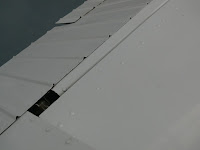Elevator assembly was simply a matter of bolting and riveting the torque tube using the pre-drilled rivet holes and nut plated installed in the elevator's. When the alignment of the hinges was checked a distinct misalignment was noted but after packing and packing it was concluded that this approach was leading in the wrong direction, time to stop and think!
The Jig
What was needed was a jig or a fixed reference and that lead to the stab which is both rigid, straight and the elevator surfaces has to bolt to it.
 |
| Packer port side |
A string line was run through the center of the four [4] hinge mounting holes and it was concluded that a 0.030'' packer was required behind the port outboard hinge to bring all onto the same center.
This was fabricated and riveted on its center to the spar using two [2] 5/32'' pop rivets and when rechecked the string was on all the hinges centers. It was now ready to be used as the jig to align the elevators using the aluminium D nose to lock the elevators into correct alignment to the stab and fuselage.
 |
| Port Side check |
 |
| Starboard Side check |
Elevator Alignment
With the fuselage level with the tail plane the assembled elevator was fitted onto the stab. The next task is to align the trailing edge of the elevator to the stab, this was achieved using another water level and a piece of lumber to hold the tubes into position.
The elevator was twisted into alignment by placing an aluminium angle prop under the inboard edge while resting on a clamp with the extra 3 x 2 there as dead weight.
 |
| Cessna D Nose |
Note: The lower edges of both D Noses had been pre-drilled before installation with the folded edge a few mm from the face of the spar. Positioning the skin equally from the face of the face of the spar located the D Nose in the correct location providing the clearance for correct operation and a neat appearance when assembled.

The supplied skin has a large excess of material - do not trim until the mounting holes have been fully drilled.
My decision to place the D nose under the skin is based on the need to control the shape to match drill, its the same arrangement used by Cessna with the profile begin the same as the Tucano's.
Finally a series holes were drilled, clecoed then the balance will be matched drilled on the bench for final riveting.
 |
| Port Elevator - Aligning & fitting D Nose |
The procedure was repeated on the starboard elevator using the same reference point on the outboard edge. The inboard edge was ignored as it was leveled with the port side as the horn is a rigid connector of the two inboard edges.
The final task will be completed at the next secession but will require removal, de-burring and removal swaf and other tasks before re-assembly and riveting.






























